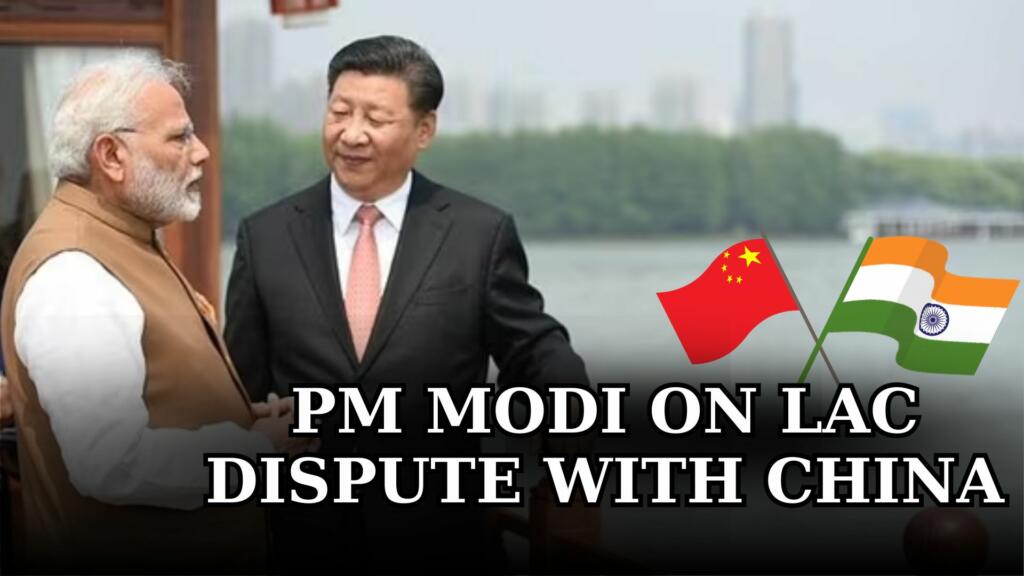In the wake of escalating tensions along the Line of Actual Control (LAC) between India and China, Prime Minister Narendra Modi has articulated a multifaceted approach aimed at addressing the bilateral dispute while positioning India as an attractive alternative for global supply chains. This strategic shift underscores India’s commitment to stability, peace, and economic growth, with a focus on leveraging its democratic values and economic reforms to emerge as a key player on the global stage.
Addressing Border Disputes
Addressing the border disputes between India and China has become a paramount concern, given the prolonged tension along the Line of Actual Control (LAC). Prime Minister Narendra Modi’s recent emphasis on the urgent need to resolve this situation underscores the gravity of the issue and the imperative of restoring normalcy in bilateral interactions.
The significance of positive and constructive engagement at both diplomatic and military levels cannot be overstated. By fostering dialogue and cooperation, both nations can work towards a resolution that ensures peace and tranquility along the border. This approach not only benefits India and China but also contributes to global and regional stability.
Stability in India-China relations is crucial for several reasons. Firstly, it promotes economic growth and development in the region. A stable relationship between the two largest countries in Asia creates a conducive environment for trade, investment, and cross-border collaboration, benefiting not only the two nations but also neighboring countries.
Moreover, stable relations between India and China are essential for global peace and security. As major powers with significant influence on the international stage, any escalation of tensions between the two countries could have far-reaching consequences. Therefore, efforts to resolve border disputes and maintain peaceful coexistence are essential for upholding the broader framework of global stability.
Furthermore, stability in India-China relations is vital for addressing shared challenges such as climate change, terrorism, and pandemics. By working together, India and China can leverage their resources and expertise to tackle these global issues effectively, benefiting not only their own citizens but also the international community as a whole.
Also Read: Jaishankar’s Sharp Wit: China’s Intentions Under Scrutiny
Economic Competence as a Competitive Edge
Prime Minister Modi’s acknowledgment of India’s economic transformations underscores the nation’s emergence as a compelling alternative for companies looking to diversify their supply chains away from China. This recognition reflects India’s evolving economic landscape, characterized by a series of reforms aimed at fostering growth and attracting investment.
India’s democratic governance serves as a fundamental pillar of its appeal to global investors. Unlike many of its regional counterparts, India boasts a robust democratic polity that ensures stability, transparency, and the rule of law. Coupled with significant economic reforms such as the implementation of the Goods and Services Tax (GST), reduction in corporation tax rates, enactment of bankruptcy legislation, and reforms in labor laws, India presents an enticing investment destination.
The introduction of the GST, in particular, has streamlined India’s indirect tax system, simplifying compliance for businesses and promoting ease of doing business. Similarly, the reduction in corporation tax rates has bolstered India’s competitiveness, making it more attractive for companies to invest and operate within its borders. Additionally, the enactment of bankruptcy legislation has strengthened India’s insolvency framework, providing greater certainty and protection for creditors and investors alike.
India’s commitment to align its regulatory frameworks and infrastructure with global standards underscores its readiness to compete on a level playing field. By embracing international best practices and investing in critical infrastructure projects, India aims to enhance its competitiveness and attract investment across various sectors.
Also Read: China’s Broken Promises & Jaishankar’s Strong Remarks for Indo-Pacific Stability
Strengthening Manufacturing Capacity
India’s commitment to strengthening its manufacturing capacity is evident through initiatives like the Production Linked Incentive (PLI) schemes, which span across 14 industries. These schemes underscore India’s proactive approach towards bolstering its manufacturing capabilities and positioning itself as a preferred destination for setting up resilient supply chains.
The PLI schemes offer financial incentives to manufacturers to enhance their production capabilities and increase domestic value addition. By incentivizing investment and production in key sectors such as electronics, solar modules, medical equipment, and vehicles, India aims to reduce dependency on imports and boost indigenous manufacturing.
India’s strengths
Its large pool of skilled labor, abundant natural resources, and growing consumer market, provide a conducive environment for manufacturing. By leveraging these advantages, India can offer competitive advantages to businesses looking to establish or expand their manufacturing operations.
Moreover, the vast Indian domestic market serves as a significant driver for manufacturing growth. With a population of over 1.3 billion people and a rising middle class, India offers a lucrative consumer base for both domestic and international businesses. By tapping into this market, manufacturers can not only meet domestic demand but also explore export opportunities, further enhancing the attractiveness of India as a manufacturing hub.
Additionally, India’s strategic geographical location and improving infrastructure networks facilitate the movement of goods within the country and across international borders. This connectivity enhances the efficiency of supply chains and reduces logistical challenges for manufacturers operating in India.
In conclusion, Prime Minister Narendra Modi’s approach reflects India’s proactive stance in addressing the challenges posed by the border tensions with China while capitalizing on its economic potential. By emphasizing the need for stability and peaceful relations alongside showcasing India’s economic reforms and manufacturing prowess, Modi’s vision positions India as a key player in the global arena. As the nation navigates through these diplomatic and economic challenges, it remains committed to fostering partnerships and promoting peace for the collective well-being of the region and the world.
Also Read: India’s Electronics Surge Sends Shockwaves to China
